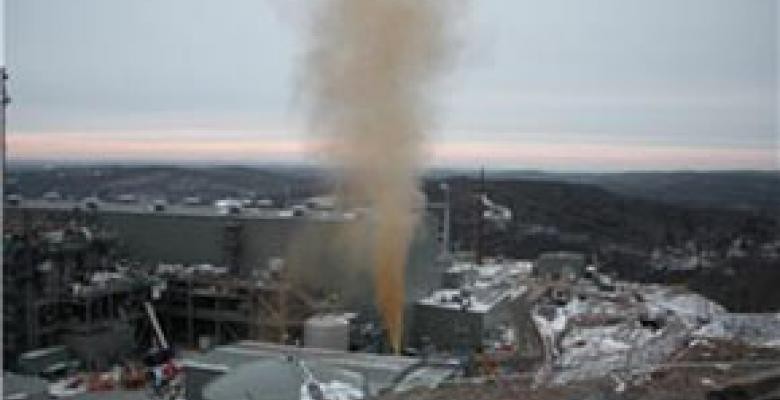Cuts in Non-CO2 Pollutants May Slow Climate Change
Reducing Soot and Methane Would Bring Fast Results, Says Study
A study by a large international team of scientists says that relatively cheap, simple measures to cut two common pollutants could substantially reduce global warming and improve human health and agriculture in coming decades.

Instead of focusing on carbon dioxide—the main culprit in climate change--they target specific ways to cut methane and soot from industrial and farming processes, using proven existing technologies. They estimate this would shave nearly one degree Fahrenheit off warming projected to occur by mid-century. The cuts would also avert premature deaths from air pollution, and boost yields of crops, they say. The new study, which builds on a report last year from the UN Environmental Programme and the World Meteorological Organization, appears this week in the leading journal Science.
Carbon dioxide, a product of human fossil-fuel and biomass burning, is the major long-term driver of global warming. But the political, economic and technological challenges to reducing emissions are huge, and once in the air, CO2 remains for centuries. Methane and soot contribute to warming too, but they naturally cycle out of the air much faster—and there are already immediate ways available to deal with them, say the authors. Methane, a flammable constituent of natural gas and natural byproduct of decay and digestion processes, is a greenhouse gas similar to CO2, but pound for pound far more potent; it also reacts with other gases to form ground-level ozone, a major pollutant that damages both crops and human health. Soot (technically known as black carbon) comes from incomplete combustion of wood, dung, coal and other fuels. It absorbs radiation from the sun, warming the air when it is aloft, and warming land when it alights there; as a side effect, it can also cause rainfall patterns to shift. It also worsens cardiovascular and respiratory diseases.
“Ultimately, we have to deal with CO2, but dealing with these pollutants is more doable, and it brings fast benefits,” said lead author Drew Shindell, a researcher at theNASA Goddard Institute for Space Studies (GISS) and Columbia University’s Earth Institute. “We have identified practical steps we can take with existing technologies. Protecting public health and food supplies may take precedence over avoiding climate change in most countries, but knowing that these measures also mitigate climate change may help motivate policies to put them into practice.”
Shindell and 23 colleagues from North America, Europe, Africa, the Mideast and Asia looked at some 400 possible existing pollution control measures that might cut global warming. Then they used computer models to zero in on 14 that would have the most immediate effects. All turned out to involve cuts in methane or soot.
To reduce methane, key strategies targeted by the study are capturing gas currently escaping from coal mines and oil- and gas-producing facilities; reducing leakage from long-distance pipelines; preventing emissions from landfills; updating wastewater treatment plants; draining rice paddies more often; and limiting emissions from manure on farms. For black carbon, strategies include installing more filters on diesel vehicles; taking the worst-polluting vehicles off the road; upgrading family cookstoves with cleaner-burning models; building more efficient brick kilns, boilers and coke ovens; and banning theroutine burning of agricultural lands now common in many parts of the tropics.
The researchers estimated that if all recommended measures were taken, it would reduce global warming by about 0.5 degree Centigrade (0.9 Fahrenheit) by 2050. (Projections of future warming vary, but the mean forecast is about 1.34 degrees C hotter by 2050 than now.) The researchers say the measures would also avert 700,000 to 4.7 million premature deaths from outdoor air pollution per year, and increase annual crop yields by 30 to 135 million metric tons, due to ozone reductions by 2030 and beyond. The scientists valued the overall benefits of methane reduction alone at $700 to $5,000 per metric ton, while the typical cost of abatement would be less than $250 per ton.
Some regions would benefit more than others. These would include regions with large amounts of snow and ice cover, where soot landing on reflective surfaces has been shown to hasten melting and expose underlying ground, which then soaks up more heat and feeds back into even more warming. In the Himalayas and the Arctic, soot reductions might reduce projected warming over the next 30 years by two thirds, according to the study. Among nations, this would give Tajikistan, Kyrgyzstan and Russia the greatest buffer against warming. Meanwhile, the south Asian countries of Bangladesh, Nepal and India would see the biggest reductions in premature deaths, due to reductions in soot. Methane is more evenly distributed in the global atmosphere than soot but it forms ozone more rapidly in hot, sunny places; partly due to this, the study projects that Iran, Pakistan and Jordan would see some of the biggest improvements in agricultural production due to reduced ozone. Southern Asia and the Sahel region of Africa would see the most benefits to farming from better seasonal rainfall patterns, brought about mainly by an overall reduction in atmospheric heating by soot. The scientists used computer models developed at GISS and the Max Planck Institute for Meteorology in Hamburg, Germany, to model the impacts of the emissions reductions.
“The scientific case for fast action on these so-called ‘short-lived climate forcers’ has been steadily built over more than a decade, and this study provides further focused and compelling analysis of the likely benefits at the national and regional level,” said Achim Steiner, executive director of the Nairobi-based UN Environmental Programme. Some other institutions involved in the study include the Joint Research Centre of the European Commission; Stockholm Environment Institute; Harvard School of Public Health; Scripps Institute of Oceanography; the Asian Institute of Technology in Bangkok; and the U.S. Environmental Protection Agency.